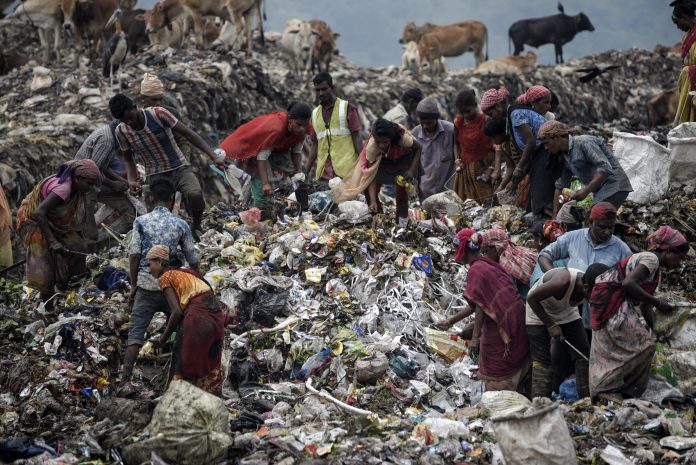
It has been more than two years since the ban on select single-use plastic items was announced in India in July 2022. Tardy implementation of the ban, coupled with a host of other factors such as poor waste disposal, lack of monitoring and loopholes in the law have catapulted India’s position to the world’s largest plastic polluter. Previous reports had placed China as the top plastic polluter. We analyze the problem and look for solutions in a series of articles.
According to new research in the journal Nature, India is responsible for around a fifth of global plastic emissions of around 9.3 million metric tons (MT) per year. Researchers at the University of Leeds say plastic emissions are highest in southern Asian, sub-Saharan African, and southeast Asian countries. Nigeria, Indonesia, and China took the second, third and fourth spots respectively.
It’s a matter of technicality if India tops the list or not but it won’t take an environmental expert to understand the gravity of plastic waste disposal and plastic pollution in India. A casual look around reveals how bad the problem is – polybags and throwaway items such as disposable cutlery, bottles and multi-layered packaging flowing out of overloaded dumpsites and public bins, on the roadsides, beside railway tracks, in rivers, on the sea shores and even high up in the hills and mountains.
Plastic ban fizzles out
So what went wrong with the ban on select single-use plastic items? Is India’s plastic pollution just a waste-management problem or much more? Is there a way forward? Packaging South Asia had a conversation with Atin Biswas, program director at the Centre for Science Environment (CSE) and Priti Banthia Mahesh, an independent researcher and campaigner, to understand the problem and find some possible answers.
see also
8 in 10 Indians
want cut in plastic
production
The problem is complex and so are the solutions as there is no one-size-fits-all approach. To quickly recall the ban, the Plastic Waste Management Amendment Rules, 2021, notified by the Ministry of Environment, Forest and Climate Change on August 12, 2021, banned the manufacture, import, stocking, distribution and sale of about 19 items with low utility and high littering potential.
The list included plastic sticks for earbuds, balloons, candy and ice cream; plastic flags; polystyrene (thermocol) for decoration; plastic plates, cups, and glasses; cutlery such as forks, spoons, knives; straws, trays; wrapping or packaging films around sweet boxes, invitation cards and cigarette packets, plastic or PVC banners less than 100 micron, and stirrers and polybags less than 120 microns.
The ministry had also notified guidelines on ‘extended producers’ responsibility’ on plastic packaging. The norms would require producers to take responsibility for environmentally sound management of a plastic product until the end of its life. The rules have been amended from time to time.
The ban worked at some levels but mostly failed at the ground level because of multiple factors – poor implementation, lack of alternatives at scale, the cheap cost and durability of plastic, the unwillingness of many plastic manufacturers to convert, confusion over the ban, etc. The absence of problem items such as multi-layered plastics (MLPs) used in packets of chips or gutkha or food products and plastic bottles from the list compounded the problem, the experts explained.
Take for example disposable cutlery. Most restaurants and branded take-way food joints shifted to bamboo or plantain leaves, paper, areca leaf, or wood products. However, small eating joints or street food operators mostly stuck to the cheaper plastic as they couldn’t afford the costlier alternatives, Priti Mahesh, who was earlier with Toxic Links, said.
Buoyed by the demand, the plastic manufacturers did not stop production – albeit in a clandestine manner. The same goes for poly bags below 120 microns, which are now freely available in every kirana store or street vendor despite the crackdowns.
“The ban was announced well in advance. However, there was little readiness as the industries were hoping for some relaxation of extension. Some of them had even appealed. The ban happened but finding alternatives wasn’t so easy. Even if alternatives were present, manufacturing them at scale was a bigger problem. The alternatives industry wasn’t ready. Then there were no tax incentives for those providing other solutions. There was a lack of sustained and planned efforts. So the execution fizzled out,” Priti Mahesh says.
Ambiguous rules
Biswas says the ban was halfhearted, ambiguous and confusing, making it difficult for state pollution control boards to penalize manufacturers. For instance, thermocol (expanded polystyrene) was banned for decoration but could be used in packaging. Similarly, plastic film is prohibited in greeting cards, sweet boxes and cigarette boxes but continues to be used in other applications. Enforcement agencies do not have control over who buys single-use plastic items after they are manufactured, he explains.
A lot of problem items such as multilayered packaging, plastic bottles for non-food-grade applications, and cigarette filters were left out of the ban, Biswas says. Hypothetically, multilayered packaging can be recycled. The layers can be separated. But as they do not meet the criteria of economy of scale, not many are interested in recycling them, he said.
“The definition of single-use plastic adopted by India does not distinguish between necessary and unnecessary plastics or between recyclable and non-recyclable plastics. Unnecessary and non-recyclable plastics need to be phased out on priority. A significant amount of problematic nonrecyclable plastics—for instance, multilayered packaging — have been allowed to circulate on the rationale that we do not have alternatives for those. Single-use plastics may be necessary and not recyclable, or it may be unnecessary but recyclable. We have oversimplified the issue of single-use plastics and set for ourselves an easy and unambitious target, leaving major polluters to continue production and distribution,” a CSE report says.
Biswas says that even if the ban were implemented with full sincerity, it would have helped reduce only 3% of plastic waste. In the initial days of the ban in 2022, the responses to complaints reported on the Central Pollution Control Board (CPCB) app were high but slowly declined. Carry bags below 120 microns are still being made and freely used with impunity.
Both Priti Mahesh and Biswas pointed to the need for public awareness. While Mahesh felt there was a concerted and sustained effort to change consumer behavior, Biswas said social gatherings – producers of bulk waste – are one of the biggest culprits where people prefer cheaper plastic items over costlier eco-friendly alternatives.
Quite a few companies have come up with eco-friendly products in the past two years. However, most of them are not at scale, costlier than plastic and unable to meet large-scale demand, the experts explained. They cautioned that the words bio-degradable and compostable are loosely used and recycling is more complex and layered than projected.
Next part: Solutions
The possible ways forward are a mix of upstream, mid-stream and downstream measures such as stricter and strategized implementation, incentives for manufacturers of sustainable alternatives, research in design, making plastic costly to deter its use, advanced recycling, proper segregation and collection, and a cut in the production of plastic, which we will discuss in a subsequent article that will also touch upon the upcoming Global Plastics Treaty meeting in Busan, South Korea from 25 November to 1 December 2024.










